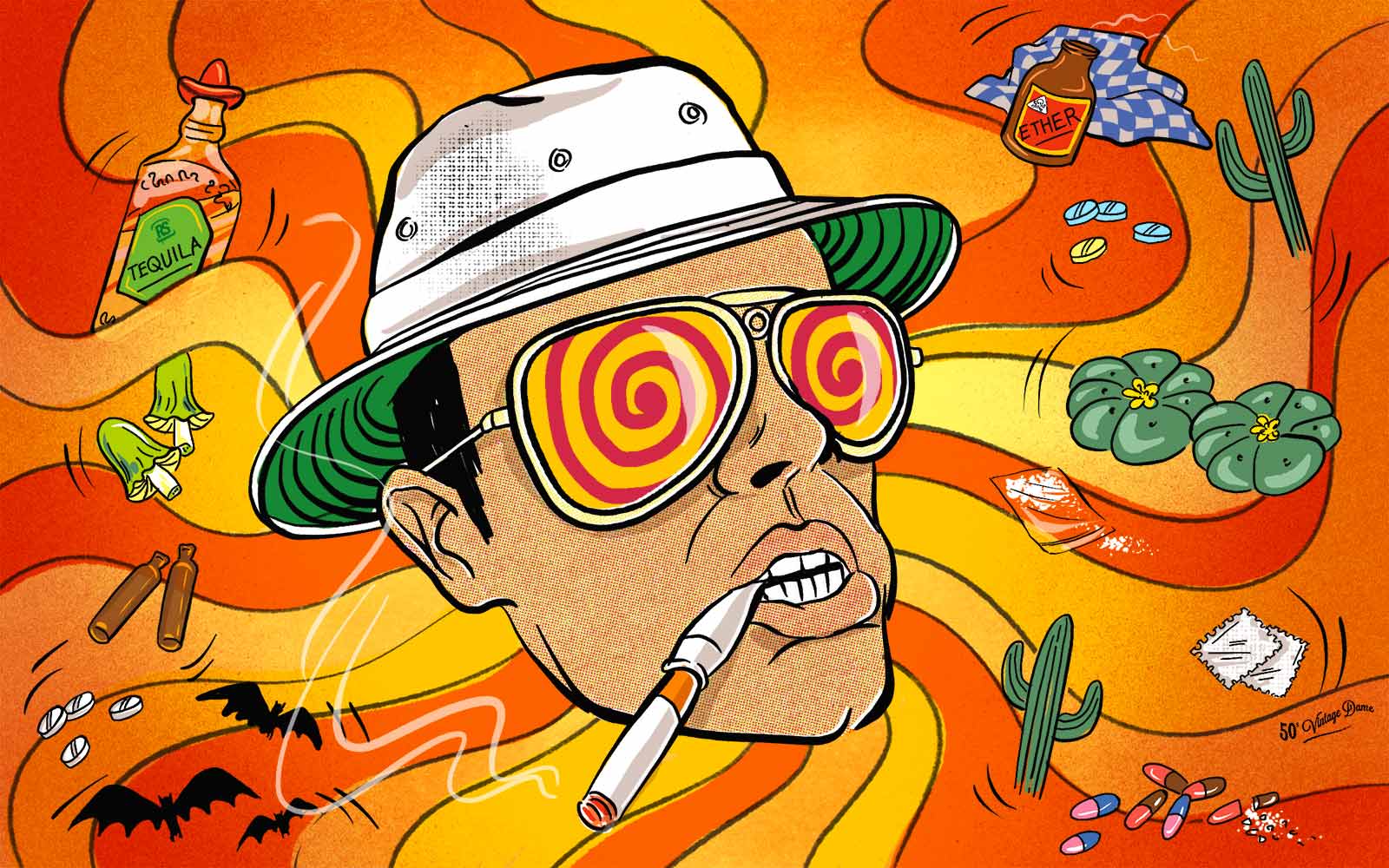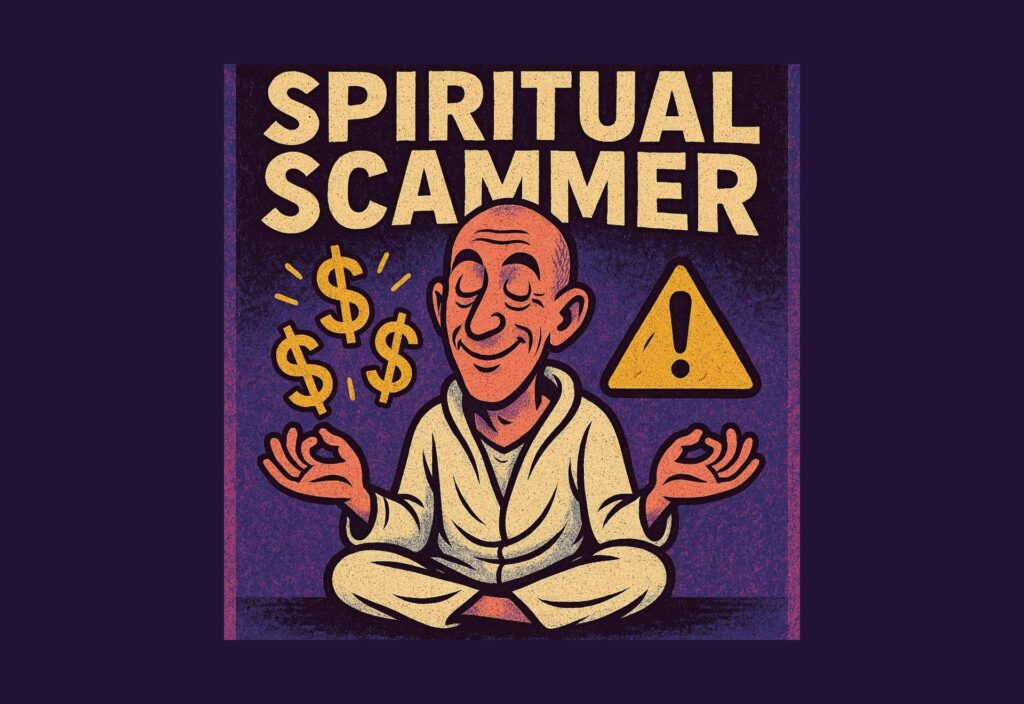Fear and Loathing in Las Vegas is both an iconic novel by the debaucherous Hunter S. Thompson and a cult classic film adaptation by Terry Gilliam. Starring Johnny Depp and Benicio Del Toro as the leading duo, Raoul Duke and Dr. Gonzo, Thompson’s 1971 tale inspired the 1998 film and left lasting impressions on the cultural psychedelic discussion. Though the book was well-received, some see the film as a tasteless show of human overconsumption without recognizing its artistic merits. By exploring and personifying Duke’s psychedelic experiences, audiences get a lens into the world of Hunter S. Thompson and consequently, the counterculture movements of the 1960s. Let’s dive in further on the topic at hand — psychedelics in film, Fear and Loathing in Las Vegas edition.
Plot Synopsis
Fear and Loathing in Las Vegas takes place in 1971, marking the draconian beginnings of the War on Drugs. This is highlighted as Duke and Gonzo zoom past a sign warning of life imprisonment for the sale of marijuana.
The original novel was based on a real journey that Thompson took to Las Vegas to report on the Mint 400 motorcycle race. The film also depicts a narcotics conference that Thompson reported on a few weeks after the race. Raoul Duke serves as the vehicle for Thompson’s consciousness, narrating the film while audiences watch him and his partner in crime Dr. Gonzo — based on Thompson’s own Attorney, Oscar Zeta Acosta — rocket around Las Vegas consuming any substance they can get their hands on in the name of journalism.
The trunk of their ruby-red convertible Impala contained more than a medicine cabinet’s worth of psychedelic, narcotic and fictionally-exaggerated substances. The ensuing journey highlights the exorbitant consumerism and stagnant rabbit holes existing in American society, especially in the context of a Las Vegas casino. As Duke and Gonzo continue to imbibe, what once was the humorous exploits of friends becomes an uncomfortable picture of ravenous depravity. Eventually, Duke writes his article and leaves the fear and loathing of Las Vegas, but not before professing his disdain for his perceived failures of the 1960s acid-fueled hippie movement.
The film is full of references to the events surrounding Thomspon’s novel. The TVs in the hotel room playing scenes of the Vietnam War and Nixon hammering on about the War on Drugs, all while Duke is blacked out on adrenochrome after his day at the district attorney’s convention on narcotics. Thompson himself was vocal about his disdain for President Nixon, labeling him everything wrong with America. The score is composed of period-specific music, often distorted, placing the audience into the same altered state of perception as the characters.
Substances Highlighted in the Film
“We had two bags of grass, seventy-five pellets of mescaline, five sheets of high-powered blotter acid, a salt shaker half full of cocaine, and a whole galaxy of multi-colored uppers, downers, screamers, laughers … and also a quart of tequila, a quart of rum, a case of Budweiser, a pint of raw ether and two dozen amyls … The only thing that really worried me was the ether.”
Raoul Duke and Dr. Gonzo both consume an extreme amount of substances. Each drug is accompanied by cinematic elements meaning to simulate the experience of the drug. Duke outlines their stash at the top of the film. Let’s go over them below.
Mescaline
Mescaline comes from a variety of desert cacti including peyote, San Pedro and Torch. It produces vivid hallucination and has long been used by indigenous peoples for religious ceremonies. The film expresses the experience of a mescaline high by making the colors on screen melt into each other and the background swirl into a kaleidoscope of the Las Vegas strip.
LSD
LSD was extremely popular at the time of Thompson’s trip to Vegas. In the film, it is shown as tabs the pair gobble down. When Duke and Gonzo are on LSD, the filmmakers use extreme wide-angle shots mimicking the expanded consciousness of the characters. Duke hallucinates a large moray eel at the hotel’s reception desk and while in a casino all the patrons turn into large reptilian creatures. The auditory landscape is also manipulated, with music and sounds morphing together.
Cocaine
Cocaine is a powdered stimulant derived from Coca leaves. It is known for its energizing and euphoric effects. Duke assesses the salt shaker of cocaine they have in their drug box on the side of the freeway into Las Vegas. Duke and Gonzo snort it throughout the film.
“Uppers”
In the same vein, Duke references the multicolored pill selection including uppers. Uppers are stimulants like cocaine, adderall and methamphetamine. The characters ingest miscellaneous pills throughout the film and there is no cinematic theme associated as they often are on a cocktail of substances.
“Downers”
Duke references downers — substances with sedative effects. This includes benzodiazepines like Xanax or Klonopin as well as barbiturates like Amytal and Nembutal. Duke and Gonzo use downers to combat their rabid stimulant consumption. Occasionally they will stare glassy-eyed at the camera, but downers are not the main substance highlighted in the film.
“Screamers” and “Laughers”
These substances can be lumped together as a metaphorical reference akin to the concept of uppers and downers. The duo has pills to make them feel any which way they choose. Screamers and laughers are not established categories of drugs but could refer to any drugs that induce the giggles or euphoria. For example ecstasy, speed or cannabis.
The effects of these substances have less of a strong cinematic presence, but the characters show behavioral and physiological signs of these drugs throughout the film.
Alcohol
Almost every character in the film consumes alcohol. Alcohol is legal and normalized in American society even though it is responsible for 261 deaths a day. Alcohol is one of the few substances that other characters, aside from the main duo, consume. Sometimes the camera swings around the casino, blurring faces of gamblers and at other times sits sedated, zooming in on scenes of drunken stupor.
Ether
Ether or diethyl ether is a surgical anesthetic and notably, the only substance Duke expresses any hesitance around. This does not stop him or Gonzo from inhaling ether as they enter a circus-themed casino. Ether affects the brain’s neural membranes and as depicted in the film causes loss of motor and psychological function. Similar to ketamine or PCP, ether is an NMDA receptor antagonist and induces dissociation and euphoria. As the pair enters the casino, high on ether, the background music is distorted and the camera view is blurred and wobbly. Duke narrates the experience of consuming ether as they anxiously make their way through security.
Amyls
Amyl nitrate is a vasodilator meaning it causes blood vessels to dilate and involuntary smooth muscles to relax. This can cause warming, euphoric sensations and relaxed muscles. The perception of light is disfigured in scenes where Duke and Gonzo take amyls. Filmmakers also implement colored filters making everything seem a shadowy range of pink and blue.
Adrenochrome
When adrenaline breaks down in the human body it naturally produces adrenochrome. In popular culture, adrenochrome is featured on television as a harvestable liquid used for nefarious purposes. In reality, adrenochrome isn’t peddled around in glass vials ready for human consumption. When isolated in medical settings, it is a deep violet pink. When under the influence of adrenochrome, Duke has the most intense and violent trip in the film. Extreme close-up shots portray the claustrophobic state Duke finds himself in as vivid, rapid images of Richard Nixon and The Vietnam War blur past.
Production and Reception
The honor of turning Hunter S. Thompson’s masterpiece into a film was desirable enough for Martin Scorsese, Oliver Stone and Terry Gilliam to pursue making this film. The cinematography of the film was inspired by the psychedelic art of Robert Yarber. The cinematographer, Nicola Pecorini, took inspiration from Yarber’s fantastical and disturbing use of light, neon color.
The filmmakers were most concerned with Thompson’s reaction to the film, which was luckily positive. The challenge of taking his experience off the page and placing it on screen was not unknown to Thompson and he praised their ability to string disparate scenes together into a narrative.
Audiences and critics alike had a mixed response to the film. Though praising filmmakers for the cinematography, viewers found the movie to lack character development and the depictions of intoxication repetitive. The impact of Thompson’s words seemed to be easier to digest when reading rather than witnessing them play out on a screen.
At the time of the film’s release, clinical study of psychoactive substances was just starting up after a long hiatus due to the legal barriers in place surrounding these medicines. In the early 2000s, researchers began exploring the possibilities of psilocybin, but popular culture was still largely anti-psychedelic. The film’s reception changes as the public consciousness shifts away from judgment and towards curiosity.
Depiction of Psychedelics in Film
The depiction of psychedelics in Fear and Loathing in Las Vegas is a very specific one — a story inspired by the ravenous appetite of Hunter S. Thompson. The cinematic features help place the audience in similar perceptual frames of mind as people on various substances. The beginning of the film paints intoxication as fun and entertaining but by the end of the film, audiences and characters alike are exhausted by the never-ending cycle of consumption. To the audience, the film showed an aimless drug binge with no real point. In order to empathize with Duke and Gonzo, viewers must be able to empathize with characters under the influences of extremely illegal substances. The picture is often ugly and disgusting and may resonate more with audiences who have their own experiences with substances.
Fear and Loathing in Las Vegas is now a cult classic and cornerstone of the psychedelic film genre. During his press tour for the film, Johnny Depp addresses the misconceptions surrounding the film. He recognizes that to some, the film is nothing more than a couple of “nutcases filling their bodies with heinous chemicals.” His understanding of the character is much more nuanced, seeing Duke’s substance-fueled journey as not one of recreation, but rather a search for meaning in a world plagued by disillusionment. Duke’s journey is Thompson’s journey and the writer’s original intentions were not only shock and voyeurism.
The film’s portrayal of American capitalism is highlighted by the protagonist’s struggle for personal freedom while still processing his own dissatisfaction with the fallacy of the American Dream. The 1960s were full of new excitement and hope for a better future. As Duke professes during the final moments of the film, the wave of change seemed to crash and pull back leaving only a legacy of grief for those seemingly naive enough to have bought into their sense of optimism.
As the world continues to evolve and the chances for disillusionment seem to multiply at an ever-quickening pace, it is worthwhile to look at stories searching for meaning. Whether fueled by substances or not, the desire for expanded consciousness and hope for the future are virtuous pursuits. Periods of fear and loathing can pass as history continues to rush forward.















